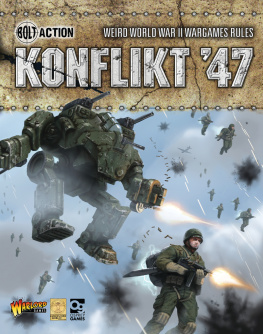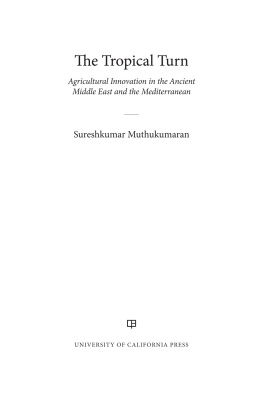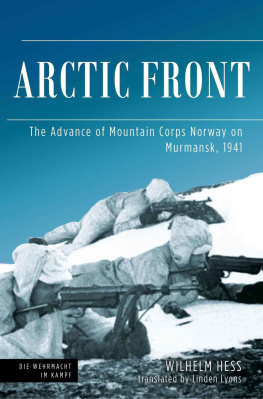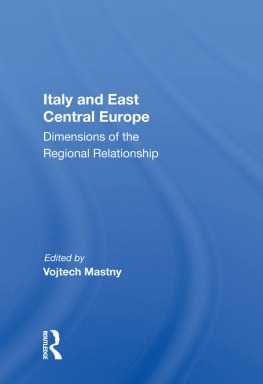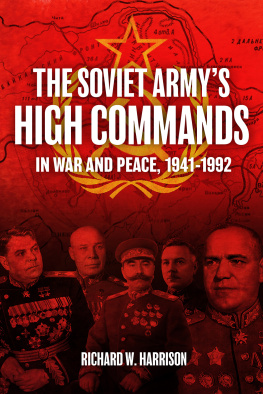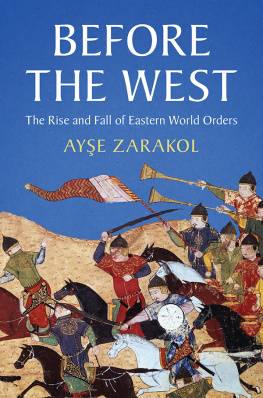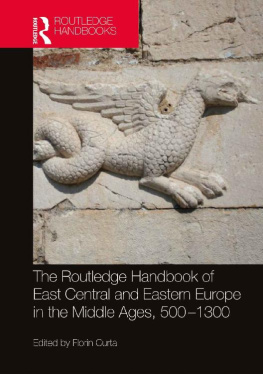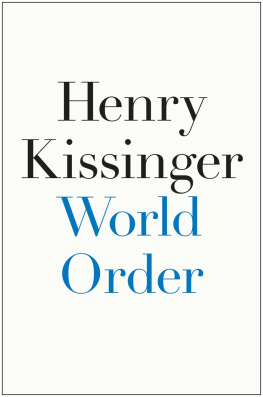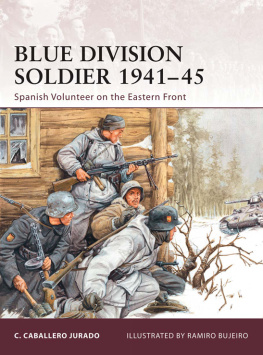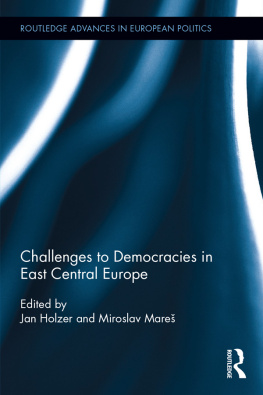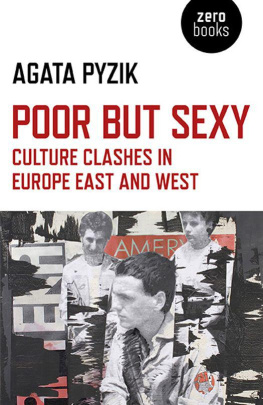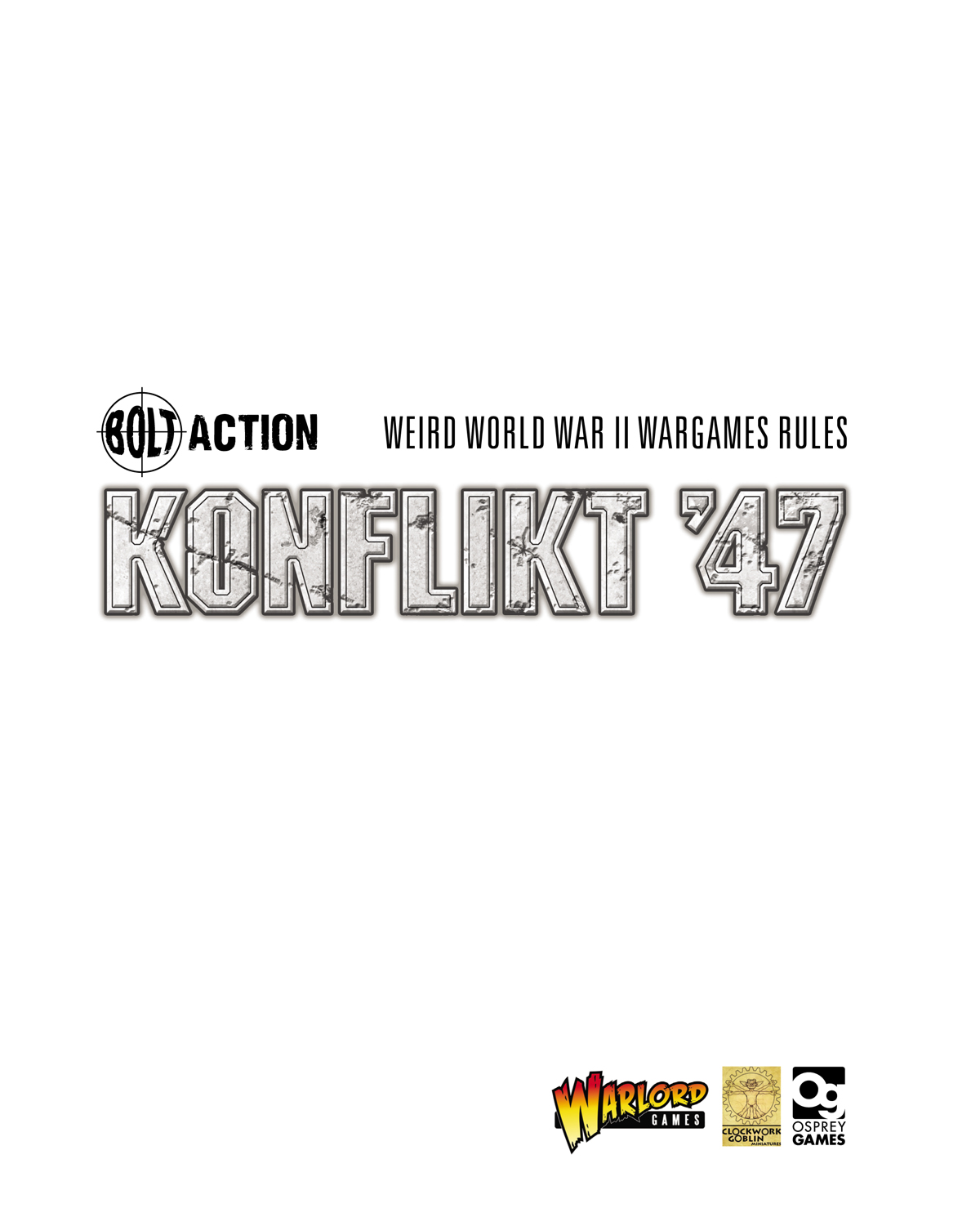
First published in Great Britain in 2016 by Osprey Games (part of Osprey Publishing),
Konflikt 47 2016 Clockwork Goblin
Bolt Action 2016 Warlord Games
This edition 2016 Osprey Publishing Ltd.
Osprey Publishing
PO Box 883, Oxford, OX1 9PL, UK
1385 Broadway, 5th Floor, New York, NY 10018
E-mail:
Osprey Publishing, part of Bloomsbury Publishing Plc
This electronic edition published in 2016 by Bloomsbury Publishing Plc
Bloomsbury is a registered trademark of Bloomsbury Publishing Plc
Warlord Games
T13/T15 Technology Wing, The Howitt Building, Lenton Business Centre, Lenton
Boulevard, Nottingham, NG7 2BD, UK
E-mail:
Clockwork Goblin
54 Bibury Rd, Cheltenham, GL51 6AY, UK
E-mail:
All rights reserved
You may not copy, distribute, transmit, reproduce or otherwise make available this publication (or any part of it) in any form, or by any means (including without limitation electronic, digital, optical, mechanical, photocopying, printing, recording or otherwise), without the prior written permission of the publisher. Any person who does any unauthorised act in relation to this publication may be liable to criminal prosecution and civil claims for damages.
A CIP catalogue record for this book is available from the British Library
ISBN: 978-1-4728-1568-2 (PB)
ISBN: 978-1-47281-570-5 (eBook)
ISBN: 978-1-47281-569-9 (ePDF)
For more information on Bolt Action and other products, please visit www.warlordgames.com
For more information on Konflikt 47, please visit www.clockworkgoblinminis.co.uk
To find out more about our authors and books visit www.ospreypublishing.com. Here you will find our full range of publications, as well as exclusive online content, details of forthcoming events and the option to sign up for our newsletters. You can also sign up for Osprey membership, which entitles you to a discount on purchases made through the Osprey site and access to our extensive online image archive.
CONTENTS
INTRODUCTION
This book is a stand-alone rules set designed using the Bolt Action World War II tabletop wargame. It contains all the rules, background and forces needed to play an alternate history or science fiction wargame set in 1947 using a fictional variation of history.
The book is divided into three sections: the first covering the background to the Konflikt 47 universe; the second covers the rules required to play the game (incorporating the technological advances found in the setting); and finally, the Army Lists together with variations to the national Army Lists
to allow their inclusion and use in the game.
Players familiar with Bolt Action will find a few changes that we think will add to their enjoyment of the game.


Konflikt 47 is set in a world very much like ours; in fact, until the middle years of World War II its history is nearly indistinguishable from our own. However, in 1943 the order of the world changed with the development of atomic weapons. The testing and use of these weapons set in motion a chain of events that would forever change the nature of the conflict and directly lead to the situation detailed in this book.
In 1943, the US Manhattan programme under Robert Oppenheimer made rapid progress in developing the joint Canadian/British atomic energy programme into a weapon that could hopefully win them the war. The testing of a prototype device at the Los Alamos Laboratory in New Mexico yielded a workable weapon in early 1944. It also, however, produced a side effect that changed history forever. At the test site, a Rift in the fabric of space formed at the heart of the detonation. This Rift stabilised over a matter of days and remains in place nearly four years later.
Before the impact or relevance of the Rift was fully understood, the US moved to end the war early, threatening Germany with an atomic attack in an effort to forestall the need for an invasion of Europe. German intransigence forced President Roosevelts hand and the Fat Boy atomic bomb was dropped on Dresden on 12 March 1944. Despite this, Hitler refused to yield and without further devices, or a desire to use them, the Allies continued planning Operation Overlord.
The Dresden detonation created another Rift, and its existence was identified by German scientists more quickly than their US counterparts studying the after-effects of the atomic weapon. Both the US and Germany then began to receive unidentifiable signals through the Rifts, mostly transmitted at radio frequencies detectable by existing equipment, but often undecipherable or hopelessly corrupted. After several weeks it became apparent that the communications were exactly that, messages from unknown originators that appeared to want to help each nations war efforts.
The US approached this situation with caution but rapidly assembled its greatest minds at the Los Alamos labs, securing the facility behind the strongest barriers and renaming it Area 51 to hide its origin and true purpose.
In Germany, less caution was exercised. Hitler, excited by the seemingly occult nature of the phenomenon, insisted on pushing the limits of safety to understand what was happening. Declaring Dresden a military-only zone, radiation proof bunkers were immediately constructed in the vicinity, allowing regular access to the Rift site at the centre of the former city. The bunkers quickly formed the heart of a research and industrial facility looking to exploit the Rift technology, or Rift-tech, to aid the war effort.
Slowly, the messages were pieced together. Much was unclear and beyond comprehension, but every so often a scientific principle or theory was deciphered that allowed each nation to make huge leaps in industrial and scientific research. Each side was unaware of the others progress, or even the existence of the parallel Rifts. Had they been, they would have quickly determined the nature of the messages differed, and the technology hinted at varied. They would have found similarities too: no messages sent back into the Rift were ever answered, and the identities of the senders remains a mystery.
Despite repeated pleas and demands from the other Allied governments, Roosevelt and the US were reluctant to share the messages coming from the Rift in New Mexico. Hitler was having similar debates with the Japanese High Command, who demanded full access; with his allies in a perilous position, Hitler made the decision to share much of the discovered Rift-tech. After a number of angry exchanges, Stalin declared the US an enemy of the Motherland in May 1944, declaring that the Soviet Union would end the war and that the US had no further role to play in mainland Europe. Churchill and the British were forced to choose sides, although it was not a hard decision to make. The Allies fractured in two, with the US, Britain, Canada now working at odds to the Soviet Union.
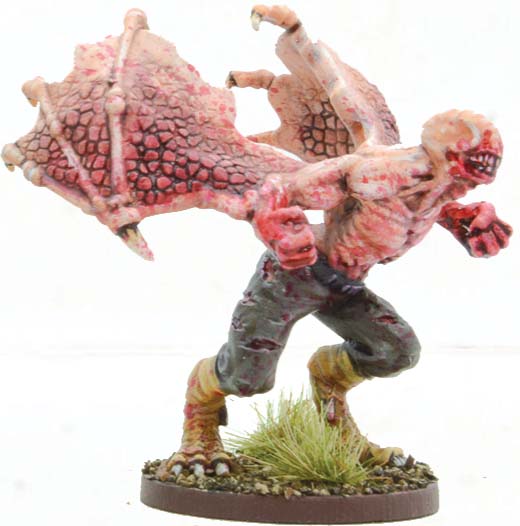
German Nachtjger
TOP SECRET: RIFT ENERGY
The exotic particles emitted by the Rifts are, paradoxically, both powerful and limited. They are unquestioningly potent, exhibiting a notable effect on organic tissue and paving the way to several biological applications.

